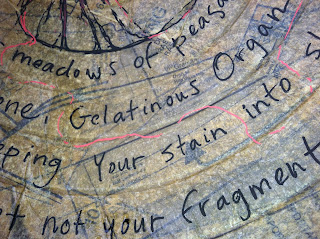A lot of new adjustments lately.
First, the glasses. I now know I have been in denial for
20 years about needing glasses for distance. It turns out
that trees are not just quivering green globs, and my family
members' faces aren't smudgy talking orbs across the room!
What else have I missed? The intensity of color and texture
at every turn is amazing, and a little dizzying as I adjust.
In my defense, my close-up vision is excellent and I don't
miss much detail of anything close (my daughters' sweet
faces before we hug, my husband's recent stint with beard-
edness), but it turns out that even an arms-length is getting
harder to see. According to Twyla Tharp, everyone has a
focal length, "All of us find comfort in seeing the world either
from a great distance, at arm's length, or in close-up." Of
course, focal length is metaphoric to Tharp, but this has me
wondering if this may mark a shift in my own art work.
Other dizzying shifts. A month ago, we moved into our new
house a day before I moved into my new Art classroom.
Spaces have shifted, systems disrupted. What? When did I
become so inflexible? From age 17 to 27, I was nomadic--
many jobs at a time, moving often. I used to be better at
change--resilient. But also, I was perpetually unsettled.
All of this moving has created more space for art making.
This is great news for making sculpture, which takes up so
much room and can not be rolled out of the way or pushed
flat against a wall. So, it is finally time to get back to making
the bowls!
 |
The first of many reimagined incantation bowls, O Body, O Incarnation,
inscribed with an incantation against cancer written by LouAnn Shepard Muhm. |
In 2010, I was educated about the large numbers of ancient
Babylonian incantation bowls, 6th-8th Century CE, that have
been unearthed in Iraq since the 1990s. Although there are some
variations, most ancient incantation bowls are shallow bisqueware
forms with a simplified character painted in the center and an
incantation against a particular fear inscribed starting along the rim
and spiraling toward the illustration. Each bowl and its incantation
was created for a specific family’s plea for assurances against fears
and was buried upside down, under the threshold of the family’s
home to ward off the fears.




















